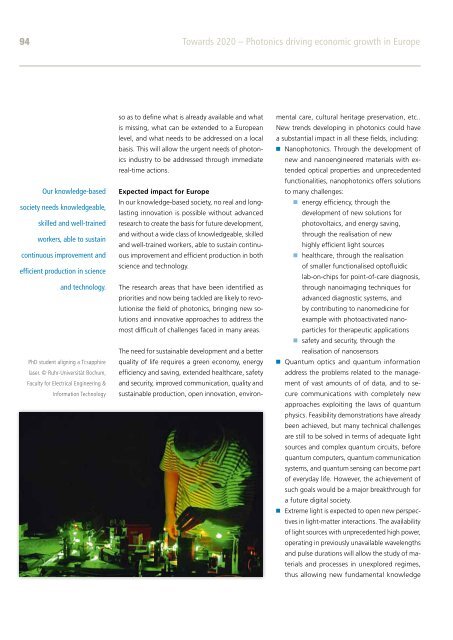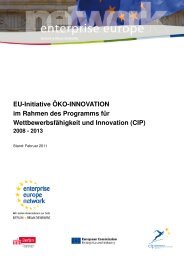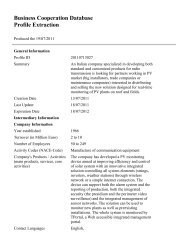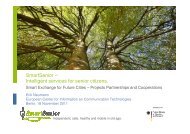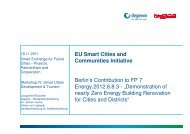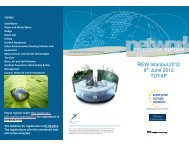Photonics Driving Economic Growth in Europe - Photonics21
Photonics Driving Economic Growth in Europe - Photonics21
Photonics Driving Economic Growth in Europe - Photonics21
Create successful ePaper yourself
Turn your PDF publications into a flip-book with our unique Google optimized e-Paper software.
94 Towards 2020 – <strong>Photonics</strong> driv<strong>in</strong>g economic growth <strong>in</strong> <strong>Europe</strong><br />
Our knowledge-based<br />
society needs knowledgeable,<br />
skilled and well-tra<strong>in</strong>ed<br />
workers, able to susta<strong>in</strong><br />
cont<strong>in</strong>uous improvement and<br />
efficient production <strong>in</strong> science<br />
and technology.<br />
PhD student align<strong>in</strong>g a Ti:sapphire<br />
laser. © Ruhr-Universität Bochum,<br />
Faculty for Electrical Eng<strong>in</strong>eer<strong>in</strong>g &<br />
Information Technology<br />
so as to def<strong>in</strong>e what is already available and what<br />
is miss<strong>in</strong>g, what can be extended to a <strong>Europe</strong>an<br />
level, and what needs to be addressed on a local<br />
basis. This will allow the urgent needs of photonics<br />
<strong>in</strong>dustry to be addressed through immediate<br />
real-time actions.<br />
Expected impact for <strong>Europe</strong><br />
In our knowledge-based society, no real and long-<br />
last<strong>in</strong>g <strong>in</strong>novation is possible without advanced<br />
research to create the basis for future development,<br />
and without a wide class of knowledgeable, skilled<br />
and well-tra<strong>in</strong>ed workers, able to susta<strong>in</strong> cont<strong>in</strong>u-<br />
ous improvement and efficient production <strong>in</strong> both<br />
science and technology.<br />
The research areas that have been identified as<br />
priorities and now be<strong>in</strong>g tackled are likely to revo-<br />
lutionise the field of photonics, br<strong>in</strong>g<strong>in</strong>g new solutions<br />
and <strong>in</strong>novative approaches to address the<br />
most difficult of challenges faced <strong>in</strong> many areas.<br />
The need for susta<strong>in</strong>able development and a better<br />
quality of life requires a green economy, energy<br />
efficiency and sav<strong>in</strong>g, extended healthcare, safety<br />
and security, improved communication, quality and<br />
susta<strong>in</strong>able production, open <strong>in</strong>novation, environ-<br />
mental care, cultural heritage preservation, etc..<br />
New trends develop<strong>in</strong>g <strong>in</strong> photonics could have<br />
a substantial impact <strong>in</strong> all these fields, <strong>in</strong>clud<strong>in</strong>g:<br />
n Nanophotonics. Through the development of<br />
new and nanoeng<strong>in</strong>eered materials with extended<br />
optical properties and unprecedented<br />
functionalities, nanophotonics offers solutions<br />
to many challenges:<br />
n energy efficiency, through the<br />
development of new solutions for<br />
photovoltaics, and energy sav<strong>in</strong>g,<br />
through the realisation of new<br />
highly efficient light sources<br />
n healthcare, through the realisation<br />
of smaller functionalised optofluidic<br />
lab-on-chips for po<strong>in</strong>t-of-care diagnosis,<br />
through nanoimag<strong>in</strong>g techniques for<br />
advanced diagnostic systems, and<br />
by contribut<strong>in</strong>g to nanomedic<strong>in</strong>e for<br />
example with photoactivated nanoparticles<br />
for therapeutic applications<br />
n safety and security, through the<br />
realisation of nanosensors<br />
n Quantum optics and quantum <strong>in</strong>formation<br />
address the problems related to the management<br />
of vast amounts of of data, and to secure<br />
communications with completely new<br />
approaches exploit<strong>in</strong>g the laws of quantum<br />
physics. Feasibility demonstrations have already<br />
been achieved, but many technical challenges<br />
are still to be solved <strong>in</strong> terms of adequate light<br />
sources and complex quantum circuits, before<br />
quantum computers, quantum communication<br />
systems, and quantum sens<strong>in</strong>g can become part<br />
of everyday life. However, the achievement of<br />
such goals would be a major breakthrough for<br />
a future digital society.<br />
n Extreme light is expected to open new perspectives<br />
<strong>in</strong> light-matter <strong>in</strong>teractions. The availability<br />
of light sources with unprecedented high power,<br />
operat<strong>in</strong>g <strong>in</strong> previously unavailable wavelengths<br />
and pulse durations will allow the study of materials<br />
and processes <strong>in</strong> unexplored regimes,<br />
thus allow<strong>in</strong>g new fundamental knowledge


